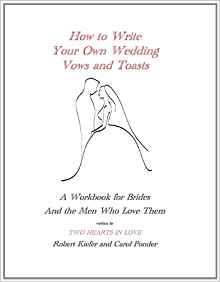Wedding vows are pledges spoken by the bride and groom
to each other. These vows communicate both an intent and a promise as they
enter into life together. When making wedding vows, traditionally the
bride and groom face each other and the groom is the first to say his vows,
followed by the bride. A newer, less-traditional practice is for the couple to
say their vows in unison, but that leaves no room for uniqueness or individual
vows. When considering traditional wedding vows vs. writing your own wedding vows
some couples run into resistance, but that is happening less as more and more
couples decide to write their own. After all, where did "traditional" vows come from? Somewhere in
the past, someone had to write them, right?
The story behind traditional wedding vows
Various religions have their own traditional wedding
vows but for the most part they are very similar. The Jewish, Hindus and Muslim
religions don’t really have “vows” in the modern sense of the word. And most of
the Eastern Orthodox Wedding Vows are made silently except in the Russian
tradition. For the most part, though, people think that the “traditional” vows
exchanged between brides and grooms today originated in the Book of Common
Prayer which dates back to 1549, but they actually go back farther than that to
a Sarum rite
used in Medieval England. So really, it isn’t unrealistic to want to step away
from vows written in the Middle Ages, and today, couples can find updated religious
and non-religious wedding vows with a traditional flavor if they want something more modern but don't feel equipped to write their own vows.
 |
| How to Write Your Own Wedding Vows |
Writing your own wedding vows
Writing your own wedding vows sounds like a good idea
on the front end, and for creative writers it can be an exercise in drawing out the
exact words hidden in their heart. But not everyone is gifted in that way and
for some it takes quite a bit of extra effort. For those who find it difficult or who get stuck in the
process, there are handy tools including the 5 steps to getting
over your wedding vows writer’s block.
Here is a list of additional resources to help write
your wedding vows:
Funny
marriage vows: Injecting a little humor in your wedding
vows is a great way to ease the tension for couples who find the formal
vow-taking a bit nerve wracking. Shutterfly
offers a funny marriage vows generator to help couples find ideas when trying
to write wedding vows that are a little more lighthearted but still meaningful.
Marriage
vows in the Bible: While the Bible doesn’t offer specific wedding vows, it considers marriage itself to be a vow. When writing your own
wedding vows, Bible verses on marriage, love, and relationships offers poetic
language that expresses what it means to be in love and to pledge yourself to
your spouse for the rest of your life. Use these verses to help define your own
vows.
Wedding
vows template: Sometimes all you need is the guidance of
a template
or outline to help you find the write words when writing our own vows.
Once you written you've written your wedding vows, read them through again and again to become familiar with saying them. Read them out loud to see if there are any words that don't flow or cause you to verbally stumble. That way you'll be ready to express yourself and say exactly what you want to say on your big day.
Some links in this post are affiliate links. We are a participant in
the Amazon Services LLC Associates Program, an affiliate advertising program
designed to provide a means for us to earn fees by linking to amazon.com and
affiliate sites.
Thanks so much for being part of our success.


